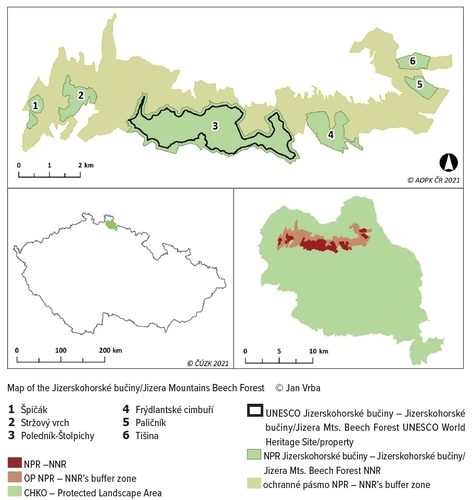Nature Conservation 2022 — 25. 5. 2022 — On Nature in the Czech Republic — Print article in pdf
The Jizerskohorské bučiny / Jizera Mountains Beech Forest National Nature Reserve – A Part of the Wo

It would not be far from the truth to say that in summer 2021 the Jizerské hory/Jizera Mountains Beech Forest National Nature Reserve (NNR) became the most often mentioned Specially Protected Area in mass media in the Czech Republic. In July 2021, the NNR was inscribed on the prestigious UNESCO World Heritage List becoming a new component of the serial World Heritage Site Ancient and Primeval Beech Forests of the Carpathians and Other Regions of Europe (Plesník & Hušek 2021). Because in previous articles we have provided only a brief description of the NNR and have paid attention more to its nomination and approval (Plesník & Hušek 2020, Plesník 2020) it is quite appropriate to present the extraordinary site not only from a point of view of nature and landscape heritage protection, conservation and management in more detail.

Rare natural monument conservation is not a question of sentimentality, but of a mandatory respect.
Karel Čapek: Beg for Mercy (1928)
Not only size but also quality matters
The Jizerské hory/Jizera Mts. Beech Forest National Nature Reserve is located on the northern slopes of the Jizerské hory/Jizera Mts. in the country’s northern part (Liberec Region, northern Bohemia), close to the Czech-Polish border (N 50°51'30", E 15°9'20"). Even at first sight it gets out of the traditional model of a single compact protected area surrounded by a buffer zone on the whole perimeter. It in fact consists of six segments covering in total impressive 950.9 hectares. To find why it is we have to go more than sixty years back into the past. In 1960, six State Nature Reserves (SNRs), namely the Oldřichovský Špičák, Poledník, Štolpichy, Frýdlantské cimbuří, Paličník and Tišina SNR, were declared at six sites in a fifteen kilometre long zone of forest growth dominated by the European Beech (Fagus sylvatica) ranging from the municipality of Oldřichov v Hájích/ Buschullersdorf up to that of Bílý potok pod Smrkem/Weissbach. After redeclaration five years later, the original Oldřichovský Špičák SNR was divided into two smaller ones, namely the Špičák and Stržový vrch SNR. The best preserved beech or spruce-beech forests on steep rocky habitat on the northern Jizerské hory/Jizera Mts. slopes became a part of the Jizerské hory/Jizera Mts. Protected Landscape Area (PLA) established in 1967.
The intention to establish a single National Nature Reserve there was for the first time presented at the conference on the 25th anniversary of the Jizerské hory/Jizera Mts. Protected Landscape Area (Pelc 1992). Globally well-known ecologist and forester Jan Jeník wrote in his peer review: “The proposal for establishing the Jizerskohorské bučiny/Jizera Mts. Beech Forest NNR is based on (i) a topical requirement to preserve a unique complex of broad-leaved deciduous forests in the forest area disastrously damaged by air pollution, particularly acid rains; (ii) a demand at the national scale to maintain a continuous complex of broad-leaved deciduous forests in marginal mountains of the Czech Highlands to keep ecosystems and genetic diversity of the Czech Republic’s forests and of the Central European Acidophilous, floweing and mountain sycamore beech forests and scree forests cover 94.5% landscape as a whole; (ii) current ecological principles of integrated nature conservation.” The robustness of the intent finally enhanced forest quality there but it also was one of the pros during a comprehensive assessment of the natural beech forest site for inscribing it on the UNESCO natural world heritage.
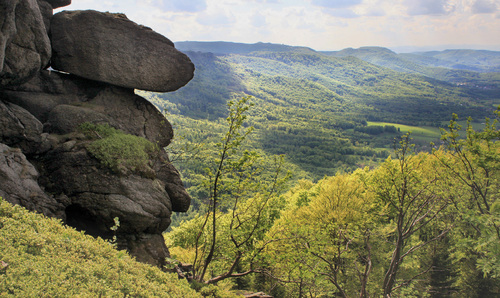
View of an extensive beech forest continuing to the northern slopes of the Jizerské hory/Jizera Mountains from Mt. Paličník © František Pelc
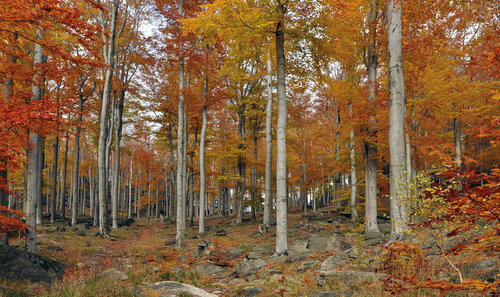
Acidophilous, floweing and mountain sycamore beech forests and scree forests cover 94.5% of the the Jizerskohorské bučiny/Jizera Mountains Beech Forest. © Jiří Hušek
After passing progressive Act No. 114/1992 Gazette on Nature Conservation and Landscape Protection, unequivocal classification of all the seven SNRs as National Nature Reserves had confirmed their at least national importance (Pelc et al. 1994). The NNR is the most strictly protected category of the Specially Protected Areas in the Czech Republic. In August 1999, long-term effort to maintain the unique ecosystem culminated by declaring the Jizerskohorské bučiny/Jizera Mts. Beech Forest NNR. The individual core areas were sensitively and at the same time functionally nested into an extensive buffer zone spreading on 1,750.4 hectares (see map on page 4). The whole area covering more than 27 km2 became a part of the PLA’s Zone I and at the same time it is one of the most extensive National Nature Reserves in the Czech Republic. It protects the most extensive complex of old-growth forest dominated by beech in Bohemia, in addition developed in unique contours of the mountain landscape with numerous outcrops of the granite bedrock (Vacek et al. 1996, 2000). The significance of the Jizerskohorské bučiny/Jizera Mts. Beech Forest was once again emphasized by including it into the well-known European Union’s Natura 2000 network, namely as the Site of European Importance (pursuant to Act No. 114/1992 Gazette on Nature Conservation and Landscape Protection, as amended later, the term for Site of Community Importance, SCI un- der the European Union’s Habitats Directive) of Jizera Mts. northern slopes causes a relatively high frequency of hard winters. The average annual temperatures, which are strongly related to altitude, range from 3 to 7.5°C. Moreover it is by 10 C higher than in the 1960s. The Jizerskohorské bučiny/Jizera Mts. Beech Forest National Nature Reserve displays an altitudinal gradient ranging from 360 to 1,006 m a.s.l.
The Jizerskohorské bučiny/Jizera Mts. Beech Forest has developed, contrary to other growths dominated by beech in the Subatlantic-Hercynic Beech Forest Region, on granites and granodiorite. The fact has significantly influenced the unique patterns in fungi, plant and animal communities (species composition, community structure, functionality, etc.) and their natural habitats. Although acidic, flowering and mountain sycamore beech forests and scree forests cover even 94.5 % of the Specially Protected Area there are important geomorphological phenomena created on steep dissected slopes by weathering and mass-wasting. Both processes resulted numerous rock formations, e.g. there are deep slopes and gorges, rock walls, overhangs, aigutes, culoirs, cracks, slabs and pillars as well as stone screes. Other geomorphological features typical for the NNR include in slopes deeply sliced valleys of various sizes, sometimes reaching a huge depth thus increasing area’s anyhow extraordinary segmentation. Mountain streams fall down some valleys through cascade rapids and waterfalls. The highest waterfall in the Jizerské hory/Jizera Mts., the Velký Štolpich Waterfall on the Černý potok/ Black Brook gets over in some steps a height of the same name (CZ0510400) and a part of the Jizerské hory/Jizera Mountains Bird Area CZ11008 (pursuant to the above act, the term for Special Protection Area, SPA under the EU Birds Directive). NNR’s unique well-preserved state and naturalness is meaningfully supported by the fact that it is together with the Mt. Praděd/Alvater NNR (the Jeseníky Mountains PLA, northern Moravia) the only Specially Protected Area in the Czech Republic meeting the demanding criteria of the category Ib, i.e. Wilderness Area, including the size set by the IUCN – International Union for Conservation of Nature (IUCN & UNEP 2021).
Map of the Jizerskohorské bučiny/Jizera Mountains Beech Forest © Jan Vrba
It is worth of mention that the UNESCO World Heritage Site property (445 hectares) and its protection buffer sub-zone (189 hectares) cover the largest NNR’s segment, i.e. two original NNR (Poledník and Štolpichy) merged after establishing the Jizerskhorské bučiny/Jizera Mts. Beech Forest NNR. Thus, the property itself includes also the Poledník area (71.6 hectares), having been left to spontaneous development as a model/study area of national importance by the agreement between the Nature Conservation Agency of the Czech Republic (NCA CR) and Forests of the Czech Republic, State Enterprise signed in May 2007. The landscape conservation buffer sub-zone covering 2,090 hectares includes not only the NNR’s buffer zone, but also 5 other NNR’s core areas. Therefore, in its some parts the protection level is stricter there than required for this zone type by UNESCO.
Not only living nature
In the Jizerskohorské bučiny/Jizera Mountains Beech Forest, both biota (the living organisms of a particular region) as well as abiotic environment are significantly influenced by very humid climate because the Jizerské hory/Jizera Mts. are the first transcontinental barrier of the humid oceanic flow from the North Sea. The average total annual rainfall is approx. 1,000 mm there. Therefore, it is one of the sites with highest total annual rainfall in the Czech Republic. By comparison: based on the most recent data, the long-term average annual precipitation is 674 mm/year in the country. The location on the Jizerské hory/30 meters. It is said that in 1814 the extremely romantic landscape inspired Carl Maria von Weber, a German composer, virtuoso pianist, and in the current wording entertainment manager, who was undergoing treatment at nearby Libverda Spa, to compose his best known opus, The Freeshooter: a rock of the same name as the famous opera ris- es on a slope above the Bílý Štolpich Brook Valley. The whole area belongs to the Odra/Oder River Basin, thus to the Baltic Sea basin.
In respect to habitats combining biota and abiotic environment, in the NNR there are five natural habitat types listed on Annex I to EU Directive 92/43/EEC on the conservation of natural habitats and of wild fauna and flora (Habitats Directive). While siliceous rocky slopes with chasmophytic vegetation (Code 8220) cover only 1% of the NNR’s territory, in the case of Luzulo-Fagetum beech forests (Code 9110) it is 65%. Other natural habitat types protected under the above EU legislation include Asperulo-Fagetum beech forests (Code 9130) occurring on 30% of the NNR and Medio-European subalpine beech woods with Acer and Rimex arifolius (Code 9140) spreading over 3%. The EU priority natural habitat type Tilio-Acerion forests of slopes, screes and ravines can be found on even lesser proportion of the Specially Protected Area, specifically on 1% of its territory.
The Forest of World Parameters
But let us go back to the phenomenon which has appeared in the NNR’s name and which has made it famous. Also in this case we have to go back to the past. For in Central Europe not so common well-preserved state the Jizerskohorské bučiny/Jizera Mts. Beech Forest has to thank to the fact that the terrain is permeable only with huge difficulties in some parts of the NNR.
That is why there has never been intensive and massive cutting/harvesting with all negative impacts on the primeval forest since the 16th century having been stimulated by high demand from famous local glass factories and later from other factories, e.g. ironworks, as it has been on the plateau. Active forest management was significantly reduced on the current NNR’s territory after World War II and in the late 1950s it was fully supressed. The main reason was technological complications and difficulties of such management. Wood was felled in summer and stored directly at the edge of the forest. In the winter, brave woodsmen then took the felled trees down steep sledge runs to the rivers, along which they were then floated to the villages and towns in the foothills. After expulsion of German old residents new settlers did not command these technologies and they were not willing to risk their lives. In addition, most of the area was not accessible even for cableways.
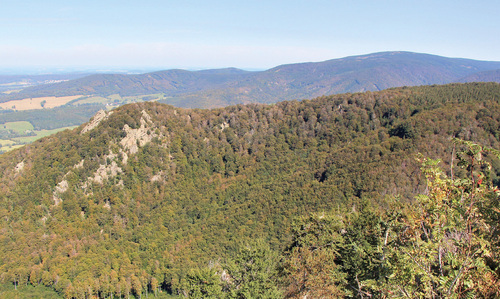
The Jizerskohorské bučiny/Jizera Mountains Beech Forest is the most extensive complex of old-growth forest dominated by beech in Bohemia. © Jan Plesník
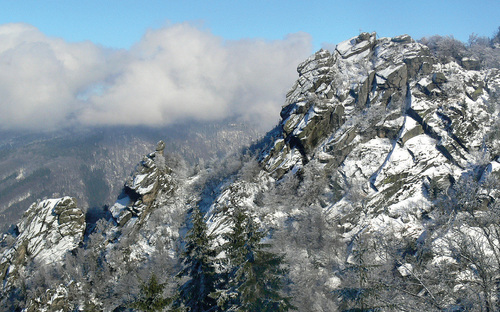
The Frýdlantské cimbuří and the Polední zub/Noon Tooth Rocks in winter. © Jiří Hušek
At a closer look we can find that neither the fifteen kilometre long structurally rich and diverse forest growth is and cannot be homogenous. Acidophilous beech forests on boulder slopes are complemented by sycamore-beech forests growing in brook deep valleys and by preserved spruce forests with rowan/mountain ash on outcrops at higher elevations. Let us remember that on most of the NNR’s territory the forest ecosystem has been left to spontaneous development for more than six decades, thus maintaining natural processes including random disturbances (temporary changes in environmental conditions that cause a pronounced change in an ecosystem). Therefore, spatial structure, plant species composition and dynamics reflect the site conditions.
Species composition of the extensive forest complex of natural character confirms, as can be expected from its name, dominance of the European beech (79 %), followed by the Norway spruce Picea abies (13%). At the same time, the Sycamore Acer pseudoplatanus (2.8%), the Rowan/Mountain ash Sorbus aucuparia (2.2%), and the Silver birch Betula pendula (1.2%) are admixed throughout, and a few species, e.g. the European larch Larix decidua (0.64%), the European ash Fraxinus excelsior (0.19%), the European silver fir Abies alba (0.08%), and the Norway maple Acer platanoides (0.01%), occur only rarely within the proposed site as well as in the Jizerské hory/Jizera Mts. as a whole. Moreover, the European silver fir has been native there displaying high dominance, but it was step-by-step eliminated by forest management and its regeneration has been blocked by overpopulated hoofed game.
The mixed beech-dominated forest in the Jizerskohorské bučiny/Jizera Mts. Beech Forest National Nature Reserve displays a huge variety of old-growth characteristics which is consistent with previously reported studies on primary old-growth forests that have never been managed or have been unmanaged for even longer time periods, e.g. multi-layered canopies, large variation in tree sizes, many large and old trees or standing dead trees. Growths older than 120 years at present occur on 67% of the NNR’s territory and the average stand age was 196 years, but the oldest tree is more than 290 years old (Lábusová et al. 2019).
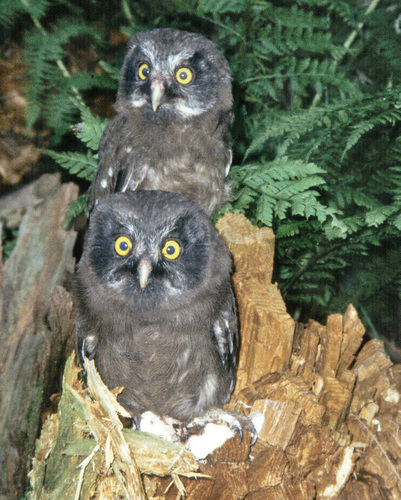
Pursuant to the Birds Directive, The Jizerské hory/Jizera Mountains Special Protection Area to protected, i.a., Tengmalm’s Owl, also known as the Boreal owl (Aegolius funereus). In the Jizerskohorské bučiny/Jizera Mountains Beech Forest the small owl nests both in natural tree holes or erected nest-boxes. © Jan Plesník
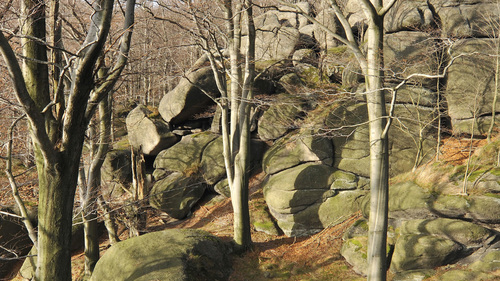
Beech stands are at many sites accompanied by granite outcrops within the NNR. © Zdeněk Patzelt
The NNR also plays an important role as a unique gene bank of native woody plant species, e.g. the European beech, Sycamore, European silver fir, Wych elm (Ulmus glabra), European ash, Sessile oak (Quercus petraea), Small-leaved lime (Tilia cordata), Large-leaved lime (Tilia platyphyllos) and the Norway maple, irreplaceable forest ecosystem restoration in the Jizerské hory/Jizera Mts. as well as in the Krkonoše/Giant Mountains.
Due to its location, the Jizerskohorské bučiny/ Jizera Mts. Beech Forest interconnects the Subatlantic-Hercynic Beech Forest Region with the Polonic-Podolic-Moldovan one, thus contributed to repeated spread the important woody plant into northern and western Europe after the end of the last glacial, 5,000–4,000 years ago (Magri 2008, Magri et al. 2006).
Fauna and flora at a close look
During a survey of lichens, in total 117 species were found within the NNR, of them 9 classified by the Red List of the Czech Republic as threatened, i.e. Critically Endangered (CR), Endangered (EN) or Vulnerable (VU). One spe- cies was reported from the Czech Republic for the first time (Malíček & Vondák 2013).
Botanical inventory confirmed in 2005 showed, that the Jizerskohorské bučiny/Jizera Mts. Beech Forest is inhabited by 357 vascular plant species: 184 live in the NNR a 339 in its buffer zone. Among from a point of view of nature conservation significant species, the Alpine coltsfoot or purple colt’s-foot (Homogyne alpina), Clasping twistedstalk (Streptopus amplexifolius), Martagon lily (Lilium martagon), Braun’s hollyfern (Polystichum braunii), Common or European yew (Taxus baccata), Wolf’s bane (Arnica montana), Broad-leaved marsh orchid (Dactylorhiza majalis), Northern firmoss (Huperzia selago), Perennial honesty (Lunaria rediviva), Stiff clubmoss (Lycopodium annotinum) or the Common bogbean (Menyanthes trifoliata).
Similarly as flora, also fauna in the Jizerskohorské bučiny/Jizera Mts. Beech Forest is not remarkable for its species richness (number of species) there, but by species diversity and particularly by its well-preserved state. The forest growth hosts, inter alia, the Fire salamander (S. salamandra), Black stork (Ciconia nigra), Honey buzzard (Pernis apivorus), Tengmalm’s Owl, also known as the Boreal owl (Aegolius funereus), Stock dove (Columba oenas) or the Red-breasted flycatcher (Ficedula parva). Rocks offer suitable nest-sites for the Eagle owl (Bubo bubo), recently also for one of the fastest animals, the Peregrine falcon (Falco peregrinus). Water habitats or their vicinity is preferred by the Swan mussel (Anodonta cygnea), European or noble crayfish (Astacus fluviatilis), European brook lamprey (Lampetra planeri), Common minnow (Phoxinus phoxinus), Alpine newt (Ichthyosaura alpestris) and the Eurasian otter (L. lutra).
NNR is not locked up
The Jizerskohorské bučiny/Jizera Mts. Beech Forest is transected by some tourist trails going through the above deep boulder valley with the Velký and Malý Štolpich Waterfalls and reaching top of the Mts. usually equipped by among visitors popular vantage points, e.g. Frýdlantské cimbuří, Ořešník, Poledník or Krásná Máří. Therefore, interested persons can visit the NNR’s most beautiful sites without harming the natural environment. Similarly to other NNRs, there also are specific rules for tourists there.
The Jizerskohorské bučiny/ Jizera Mts. Beech Forest yesterday, today and tomorrow
Due to difficult accessibility and since the 1960s also effective territorial conservation through protected areas, the Jizerskohorské bučiny/ Jizera Mts. Beech Forest displays high ecosystem integrity: all significant extremely valuable natural ecological and evolutionary processes, functions and services are not almost not influenced by humans. Maintaining and if possi- ble, improving values common for all UNESCO natural World Heritage Sites dispersed all over the world should be ensured by the The Jizerskohorské bučiny/Jizera Mountains Beech Forest National Nature Reserve Management Plan for 2021–2030 (NCA CR 2021) implemented by the State Nature Conservancy authorities in co-operation with the Forests of the Czech Republic, State Enterprise, and other stakeholder. Nature is worthy of it there. ■
List of referencies
AOPK ČR (2021): Plán péče o národní přírodní rezervaci Jizerskohorské bučiny na období 2021 – 2030. AOPK ČR, regionální pracoviště Liberecko Liberec, 87 pp. + xcvii. - IUCN & UNEP (2021): Czech Republic.
The World Database on Protected Areas. UNEP-WCMC Cambridge, U.K. https://www.protectedplanet.net/en/search-areas?filters%5Blocation%5D%5Btype%5D=country&filters%5Blocation%5D%5Boptions%5D%5B%5D=Czech+Republic&filters%5Biucn_category%5D%5B%5D=Ib.
Lábusová J., Morrissey R.C., Trotsiuk V., Janda P., Bače R., Cada V., Mikoláš M., Mrhalová H., Schurman J.S., Svobodová K., Mateju L, Synek M. & Svoboda M. (2019). Patterns of forest dynamics in a secondary old-growth beech-dominated forest in the Jizera Mountains Beech Forest Reserve, Czech Republic. iForest 12: 17-26.
Magri D. (2008): Patterns of post-glacial spread and the extent of glacial refugia of European beech (Fagus sylvatica). J. Biogeogr. 35: 450-463.
Magri D., Vendramin G.G., Comps B., Dupanloup I., Geburek Th., Gömöry D., Latowa M., Litt Th. Paule L., Roure J.M., Tantau I., van der Knapp W.O., Petit R.J. & de Beaulieu J.-L. (2006): A new scenario for the Quaternary history of European beech populations: palaeobotanical evidence and genetic consequences. New Phytol. 17: 199-221.
Malíček J. & Vondrák J. (2013): Lišejníky NPR Jizerskohorské bučiny. AOPK ČR, regionální pracoviště Liberecko Liberec, 7 pp.
Pelc F. (1992): Projekt záchrany největšího komplexu bučin v Čechách. Sborník 25 let chráněné krajinné oblasti Jizerské hory. Český ústav ochrany přírody – Správa CHKO Jizerské hory Liberec: 72-75.
Pelc F. et al. (1994): Návrh Národní přírodní rezervace Jizerskohorské bučiny. Český ústav ochrany přírody – Správa CHKO Jizerské hory Liberec, 70 pp.
Plesník J. (2020): V Jizerských horách se uskutečnila hodnotící návštěva IUCN/UNESCO. Ochrana přírody 75 (5): vii. - Plesník J. & Hušek J. (2020): Bude mít Česká republika první přírodní lokalitu světového dědictví UNESCO? Ochrana přírody 75 (1): ii-iii.
Plesník J. & Hušek J. (2021): Česká republika se může pyšnit první přírodní lokalitou světového dědictví UNESCO. Ochrana přírody 76 (4): ii-iii.
Vacek S., Podrázský V. & Pelc F. (1996): Ekologické poměry, skladba a management komplexu Jizerskohorských bučin. Lesnictví - Forestry 42 (1): 20-34.
Vacek S., Souček J. & Podrázský V. (2000): Natural conditions and management of the forest complex Jizerskohorské bučiny. J. Forest Sci. 46: 445- 467.
Višňák R. (2005): Inventarizační průzkum NPR Jizerskohorské bučiny z oboru botanika (floristika, fytocenologie, biotopy). Správa CHKO Jizerské hory Liberec, 83 pp.


